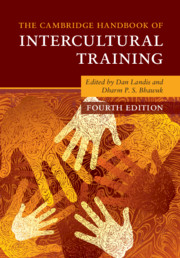Book contents
- The Cambridge Handbook of Intercultural Training
- Reviews
- The Cambridge Handbook of Intercultural Training
- Copyright page
- Dedication
- Frontispiece
- Contents
- Figures
- Tables
- Editors and Contributors
- Foreword
- Preface
- 1 Introduction and Theoretical Framework
- Part I Theoretical Foundations of Intercultural Training
- 2 Harry Triandis’s Contributions to Intercultural Training as a Field of Research
- 3 Interdisciplinary History of Intercultural Communication Studies
- 4 Culture Theories and Intercultural Training
- 5 An Analysis of Methods for Intercultural Training
- 6 Intercultural Simulations
- 7 Toward a Social Network Theory of Reentry
- 8 Intractable Conflict, Delegitimization, and Intercultural Training
- 9 Evaluation of Cross-Cultural Training
- Part II Practice of Intercultural Training
- Part III Indigenous Psychology and Intercultural Training
- Part IV New Interdisciplinary Approaches to Intercultural Training
- Part V Summing Up
- Index
- References
5 - An Analysis of Methods for Intercultural Training
from Part I - Theoretical Foundations of Intercultural Training
Published online by Cambridge University Press: 18 September 2020
- The Cambridge Handbook of Intercultural Training
- Reviews
- The Cambridge Handbook of Intercultural Training
- Copyright page
- Dedication
- Frontispiece
- Contents
- Figures
- Tables
- Editors and Contributors
- Foreword
- Preface
- 1 Introduction and Theoretical Framework
- Part I Theoretical Foundations of Intercultural Training
- 2 Harry Triandis’s Contributions to Intercultural Training as a Field of Research
- 3 Interdisciplinary History of Intercultural Communication Studies
- 4 Culture Theories and Intercultural Training
- 5 An Analysis of Methods for Intercultural Training
- 6 Intercultural Simulations
- 7 Toward a Social Network Theory of Reentry
- 8 Intractable Conflict, Delegitimization, and Intercultural Training
- 9 Evaluation of Cross-Cultural Training
- Part II Practice of Intercultural Training
- Part III Indigenous Psychology and Intercultural Training
- Part IV New Interdisciplinary Approaches to Intercultural Training
- Part V Summing Up
- Index
- References
Summary
Various issues related to training methods and outcomes of intercultural training are reviewed by employing a typology of intercultural training that integrates aspects of culture-specific and culture-general training with didactic and experiential learning styles. This is followed by a brief discussion of the process of experiential learning, issues pertaining to cognitive affective and behavioral training, how context shapes the selection of methods, and how traditional methods can be updated with technology to meet modern needs. The role of culture in shaping the choice of methods and issues related to training across and about cultures is discussed.How knowledge, skill and attitudes shape the selection of intercultural training methods, and the significance of personal and cultural preferences in mediating training outcomes, and the interaction between desired outcomes, participant data, and situational factors are noted. In addition, 20 intercultural methods –lectures, written materials, online-based training, films, self-assessment, case studies, and critical incidents, role playing, simulation games, and intercultural exercises, contrast culture training, culture assimilator, cross-cultural analysis, cross-cultural dialogues, areas studies, immersion, visual imagery, and art and culture – that are currently employed are analyzed to examine current trends in training, the contexts in which methods are applied, and the factors that affect the choice of one method over another. The analyses include an assessment of strengths and weaknesses, typical outcomes, adaptability, ways the methods have or could be used, availability of the method in off-the-shelf versions, and resources for finding out more about it.Trainers are encouraged to master a variety of methods because no single method will work all of the time in producing the desired outcomes that best suit their client’s needs.
- Type
- Chapter
- Information
- The Cambridge Handbook of Intercultural Training , pp. 192 - 257Publisher: Cambridge University PressPrint publication year: 2020
References
- 1
- Cited by



